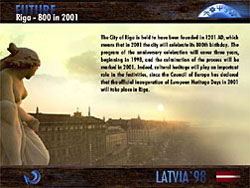
Good photography and design help make the CD-ROM fun to watch. Captions for some images, however, would be helpful.
Latvia’s image in the West is a constant struggle. As a small country, it battles for recognition on the international stage. And sometimes the recognition Latvia gets is not favorable. So when something like the CD-ROM Latvia 98: An Interactive Guide comes along, we can be thankful that it presents the country in a clear, creative and professional manner.
I have to admit I was a bit worried when I opened the CD-ROM and read the liner notes, which offered installation instructions in faulty English. Fortunately, the text, audio and video on the CD-ROM itself are well produced.
Latvia 98: An Interactive Guide was created by Rīga-based R & I Demo and released shortly before Independence Day in November. Designed for fast computers running Windows 95, Windows 98 or Windows NT, the CD-ROM presents a survey of Latvia’s history, geopolitical situation, environment, future events, culture and social life, tourism, economy, and education. Readers are guided through the presentation by a menu that uses traditional Latvian symbols as metaphors. Unfortunately, nowhere are the symbols themselves explained. Voiceovers in English are by Kārlis Streips, the Chicago-born Latvian who has made a name for himself in Rīga’s television market.
Aside from a few gaffes (such as disagreement about whether Latvia’s first international recognition came in 1920 or 1921), the CD-ROM is well done. However, I am left with a few questions and suggestions for a future project.
In the “Latvia 80” section, Latvia’s early history is covered quickly, perhaps almost too quickly. On the other hand, too much history might keep the reader from the purpose of the CD-ROM, which is to present Latvia today. In this section, as well as throughout the CD-ROM, captions on many of the photographs would be appreciated. Was that Kārlis Ulmanis we saw in one picture? Hey, wasn’t that Anatolijs Gorbunovs in another? Because this CD-ROM is meant more for a non-Latvian audience, brief explanations of these people and their roles in Latvia’s history would be helpful.
The geopolitical section presents basic information on government, geography, major cities, currency and religion.
The section on environment looks at flora, fauna, national parks, and climate. Here again, captions would be encouraged to let the reader know what animal or plant is pictured. In addition, the climate section needs to go into more detail than just showing the range of temperatures during the four seasons. Is Latvia a wet or dry place? How much rain or snow does it receive in an average year?
Perhaps the weakest section of the CD-ROM is the one devoted to the future. All we get here is brief mention of three major upcoming events: the European Reconstruction and Development Bank Summit in 2000, Rīga’s 800th anniversary in 2001, and the World Bank Summit in 2002. What about other items on the agenda in Latvia’s future, such as the possibility of joining NATO or the European Union?
The richest section, I was pleased to see, was the one focused on Latvian culture and society, presenting the reader with background on such broad topics as architecture, music and dance, the visual arts, and ethnography. A surprising section under the rubric of architecture was the one focused on memorial art found in Latvian cemeteries. Under music, we are treated to a video of Laima Vaikule in concert (of course, we don’t know that, because nowhere does it say it’s her!). One trouble spot was the section on the mass media. While several major Latvian newspapers are noted, none of the Russian-language press is mentioned. No doubt the producers of Latvia 98 wanted to tread carefully around some touchy issues such as the questions of language and citizenship.
In the section on tourism, potential visitors to Latvia are given some good reasons to visit the country as well as some practical information. Similarly, the section on Latvia’s economy encourages investment in the country. I was pleased to see that in this section, at least, Latvia 98 extended the notion of interactivity by adding a Web link to the Latvian Development Agency. More such links throughout the CD-ROM would be encouraged.
Finally, the education section gives us a quick look at the schools and universities of Latvia.
If you speak Latvian and follow current events, this CD-ROM probably won’t teach you anything. But you might want to consider purchasing a copy for your local school or public library’s multimedia collection.
(Editor’s note: This article originally appeared on SVEIKS.com.)
Details
Latvia 98
Viesturs Šutko et al.
Rīga: R&I Demo, 1998
Notes: Minimum requirements are Windows 95 running on computer running at 133 MHz, 16 MB of RAM and 1 MB video RAM.
On the Web
R & I Demo
The Rīga-based publisher of the Latvia 98 CD-ROM is R& I Demo. EN LV
© 1995-2024 Latvians Online
Please contact us for editorial queries, or for permission to republish material. Disclaimer: The content of Web sites to which Latvians Online provides links does not necessarily reflect the opinion of Latvians Online, its staff or its sponsors.




